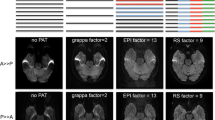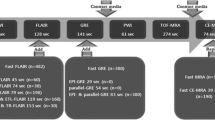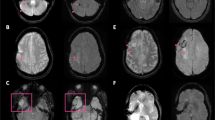Abstract
Recently, a new MRI technique was developed at 3 Tesla (T), called fluid attenuated inversion recovery* (FLAIR*). In this study, we implemented FLAIR* in an existing MS cohort at 7 T, to investigate whether we could corroborate results of previous 7 T studies that introduced specific MS lesion characteristics. Furthermore, we aimed to investigate the meaning of these lesion characteristics by relating them to clinical characteristics of the MS patient. Three-dimensional FLAIR and T2*-weighted images of 33 MS patients and 7 healthy controls were fused into FLAIR* images. Lesion type, signal intensity and morphology were analysed on FLAIR*, side-by-side with the original FLAIR and T2*, and correlated with clinical characteristics using Spearman’s rho. Three morphological features of MS lesions were visualised: (1) central vessel (CV) within lesions, present in 78 % of total MS lesions; (2) hypointense rims around MS lesions, present in eight patients; (3) FLAIR* lesions that were hypointense at T2*, present in 13 patients. The presence of hypointense (rims around) lesions was not related to clinical characteristics. The simultaneous presence of rimlike lesions and hypointense lesions within MS patients was significantly correlated (ρ = 0.52, P < 0.01). We conclude that the implementation of the new MRI technique FLAIR* at ultra-high-field 7 T combines and corroborates the results of preceding 7 T research, by showing three morphological features of MS lesions. In addition, our study shows that these phenomena do not show a relation to patient’s clinical characteristics and cannot be allocated to certain MS disease subtypes.






Similar content being viewed by others
References
Wattjes MP, Barkhof F (2009) High field MRI in the diagnosis of multiple sclerosis: high field-high yield? Neuroradiology 51:279–292
Kilsdonk ID, de Graaf WL, Barkhof F, Wattjes MP (2012) Inflammation high-field magnetic resonance imaging. Neuroimaging Clin N Am 22:135–157
Kilsdonk ID, de Graaf WL, Soriano AL et al (2013) Multicontrast MR imaging at 7T in multiple sclerosis: highest lesion detection in cortical gray matter with 3D-FLAIR. AJNR Am J Neuroradiol 34:791–796. doi:10.3174/ajnr.A3289
Filippi M, Evangelou N, Kangarlu A et al (2014) Ultra-high-field MR imaging in multiple sclerosis. J Neurol Neurosurg Psychiatry 85:60–66
Tallantyre EC, Morgan PS, Dixon JE et al (2009) A comparison of 3T and 7T in the detection of small parenchymal veins within MS lesions. Invest Radiol 44:491–494
Ge Y, Zohrabian VM, Grossman RI (2008) Seven-Tesla magnetic resonance imaging: new vision of microvascular abnormalities in multiple sclerosis. Arch Neurol 65:812–816
Tallantyre EC, Brookes MJ, Dixon JE et al (2008) Demonstrating the perivascular distribution of MS lesions in vivo with 7-Tesla MRI. Neurology 70:2076–2078
Dawson J (1916) The histology of disseminated sclerosis. Trans R Soc Edinburgh 50:517–740
Kollia K, Maderwald S, Putzki N et al (2009) First clinical study on ultra-high-field MR imaging in patients with multiple sclerosis: comparison of 1.5T and 7T. AJNR Am J Neuroradiol 30:699–702
Hammond KE, Metcalf M, Carvajal L et al (2008) Quantitative in vivo magnetic resonance imaging of multiple sclerosis at 7 Tesla with sensitivity to iron. Ann Neurol 64:707–713
Mainero C, Benner T, Radding A et al (2009) In vivo imaging of cortical pathology in multiple sclerosis using ultra-high field MRI. Neurology 73:941–948
Pitt D, Boster A, Pei W et al (2010) Imaging cortical lesions in multiple sclerosis with ultra-high-field magnetic resonance imaging. Arch Neurol 67:812–818
Sati P, George IC, Shea CD et al (2012) FLAIR*: a combined MR contrast technique for visualizing white matter lesions and parenchymal veins. Radiology 265:926–932
Polman CH, Reingold SC, Edan G et al (2005) Diagnostic criteria for multiple sclerosis: 2005 revisions to the “McDonald Criteria”. Ann Neurol 58:840–846
Kurtzke J (1983) Rating neurologic impairment in multiple sclerosis: an expanded disability status scale (EDSS). Neurology 33:1444–1452
Visser F, Zwanenburg JJM, Hoogduin JM, Luijten PR (2010) High-resolution magnetization-prepared 3D-FLAIR imaging at 7.0 Tesla. Magn Reson Med 64:194–202
De Graaf WL, Zwanenburg JJM, Visser F et al (2012) Lesion detection at seven Tesla in multiple sclerosis using magnetisation prepared 3D-FLAIR and 3D-DIR. Eur Radiol 22:221–231
Geurts JJG, Roosendaal SD, Calabrese M et al (2011) Consensus recommendations for MS cortical lesion scoring using double inversion recovery MRI. Neurology 76:418–424
Tallantyre EC, Dixon JE, Donaldson I et al (2011) Ultra-high-field imaging distinguishes MS lesions from asymptomatic white matter lesions. Neurology 76:534–539
Wuerfel J, Sinnecker T, Ringelstein EB et al (2012) Lesion morphology at 7 Tesla MRI differentiates Susac syndrome from multiple sclerosis. Mult Scler 18:1592–1599
Sinnecker T, Dörr J, Pfueller CF et al (2012) Distinct lesion morphology at 7-T MRI differentiates neuromyelitis optica from multiple sclerosis. Neurology 79:708–714
Tan IL, van Schijndel RA, Pouwels PJW et al (2000) MR venography of multiple sclerosis. AJNR Am J Neuroradiol 21:1039–1042
De Leeuw FE, de Groot JC, Achten E et al (2001) Prevalence of cerebral white matter lesions in elderly people: a population based magnetic resonance imaging study. The Rotterdam Scan Study. J Neurol Neurosurg Psychiatry 70:9–14
Gawne-Cain ML, Silver NC, Moseley IF, Miller DH (1997) Fast FLAIR of the brain: the range of appearances in normal subjects and its application to quantification of white-matter disease. Neuroradiology 39:243–249
Ropele S, de Graaf W, Khalil M et al (2011) MRI assessment of iron deposition in multiple sclerosis. J Magn Reson Imaging 34:13–21
Yao B, Bagnato F, Matsuura E et al (2012) Chronic multiple sclerosis lesions: characterization with high-field-strength MR imaging. Radiology 262(1):206–215
Grabner G, Dal-Bianco A, Schernthaner M et al (2011) Analysis of multiple sclerosis lesions using a fusion of 3.0 T FLAIR and 7.0 T SWI phase: FLAIR SWI. J Magn Reson Imaging 33:543–549
Bagnato F, Hametner S, Yao B et al (2011) Tracking iron in multiple sclerosis: a combined imaging and histopathological study at 7 Tesla. Brain 134:3599–3612
Haacke EM, Makki M, Ge Y et al (2009) Characterizing iron deposition in multiple sclerosis lesions using susceptibility weighted imaging. J Magn Reson Imaging 29:537–544
Kilsdonk ID, Wattjes MP, Geurts JJG (2014) Ultra-high field MRI: looking through the “macroscope”. J Neurol Neurosurg Psychiatry 85:4
Bian W, Harter K, Hammond-Rosenbluth KE et al (2013) A serial in vivo 7T magnetic resonance phase imaging study of white matter lesions in multiple sclerosis. Mult Scler 19:69–75
Bluestein KT, Pitt D, Sammet S et al (2012) Detecting cortical lesions in multiple sclerosis at 7 T using white matter signal attenuation. Magn Reson Imaging 30:907–915
Walsh AJ, Lebel RM, Eissa A et al (2013) Multiple Sclerosis: validation of MR Imaging for quantification and detection of iron. Radiology 267:531–542
Van Horssen J, Singh S, van der Pol S et al (2012) Clusters of activated microglia in normal-appearing white matter show signs of innate immune activation. J Neuroinflammation 9(1):156
De Groot CJ, Bergers E, Kamphorst W et al (2001) Post-mortem MRI-guided sampling of multiple sclerosis brain lesions: increased yield of active demyelinating and (p)reactive lesions. Brain 124:1635–1645
Acknowledgments
This work was supported by a grant provided by the Dutch MS Research Foundation (grant no. 11-769 and EU-FP7) and the Noaber Foundation (Lunteren, the Netherlands).
Conflicts of interest
The authors declare that they have no relevant conflicts of interest.
Ethical standard
This study has been approved by our institutional ethics committee. It therefore has been performed in accordance with the ethical standards laid down in the 1964 Declaration of Helsinki and its later amendments. All subjects gave written informed consent prior to participating in the study.
Author information
Authors and Affiliations
Corresponding author
Rights and permissions
About this article
Cite this article
Kilsdonk, I.D., Lopez-Soriano, A., Kuijer, J.P.A. et al. Morphological features of MS lesions on FLAIR* at 7 T and their relation to patient characteristics. J Neurol 261, 1356–1364 (2014). https://doi.org/10.1007/s00415-014-7351-6
Received:
Revised:
Accepted:
Published:
Issue Date:
DOI: https://doi.org/10.1007/s00415-014-7351-6




